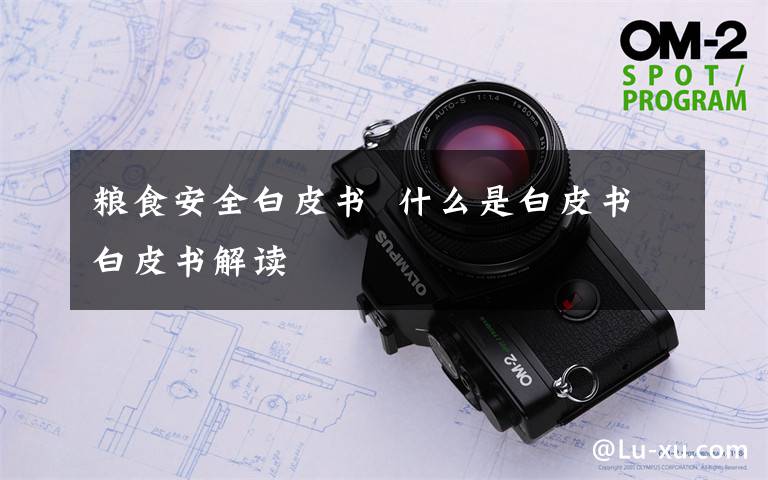国务院新闻办公室10月14日发布《中国的粮食安全》白皮书。全文如下:
中国的粮食安全Food Security in China
(2019年10月)中华人民共和国国务院新闻办公室State Council Information Office of the People's Republic of ChinaOctober 2019
目录Contents
前言Preamble
一、中国粮食安全成就I. China's Achievements in Ensuring Food Security
二、中国特色粮食安全之路II. Food Security in China
三、对外开放与国际合作III. Opening Up and International Cooperation
四、未来展望与政策主张IV. Prospects and Policies
结束语Conclusion
前言Preamble
民为国基,谷为民命。粮食事关国运民生,粮食安全是国家安全的重要基础。新中国成立后,中国始终把解决人民吃饭问题作为治国安邦的首要任务。70年来,在中国共产党领导下,经过艰苦奋斗和不懈努力,中国在农业基础十分薄弱、人民生活极端贫困的基础上,依靠自己的力量实现了粮食基本自给,不仅成功解决了近14亿人口的吃饭问题,而且居民生活质量和营养水平显著提升,粮食安全取得了举世瞩目的巨大成就。The people are the foundation of a country; food is the primary need of the people. As food decides national prosperity and the people's wellbeing, food security is a major prerequisite for national security. Since the founding of the People's Republic of China (PRC) in 1949, China has always prioritized food security in state governance. Despite a weak agricultural foundation and extreme poverty, the Communist Party of China (CPC) has led an unremitting campaign of hard work over the past 70 years that has made China basically self-sufficient in food supply. China now has enough food to feed its nearly 1.4 billion population, and has remarkably improved the people's nutrition and life quality. China's food security is a success of worldwide significance.
党的十八大以来,以习近平同志为核心的党中央把粮食安全作为治国理政的头等大事,提出了“确保谷物基本自给、口粮绝对安全”的新粮食安全观,确立了以我为主、立足国内、确保产能、适度进口、科技支撑的国家粮食安全战略,走出了一条中国特色粮食安全之路。中国坚持立足国内保障粮食基本自给的方针,实行最严格的耕地保护制度,实施“藏粮于地、藏粮于技”战略,持续推进农业供给侧结构性改革和体制机制创新,粮食生产能力不断增强,粮食流通现代化水平明显提升,粮食供给结构不断优化,粮食产业经济稳步发展,更高层次、更高质量、更有效率、更可持续的粮食安全保障体系逐步建立,国家粮食安全保障更加有力,中国特色粮食安全之路越走越稳健、越走越宽广。Since the CPC's 18th National Congress in 2012, the CPC Central Committee with Xi Jinping as its core has treated food security as a top state issue. The central leadership has introduced a food security policy of "ensuring basic self-sufficiency of grain and absolute security of staple food". The Chinese government has established a national strategy on food security featuring self-sufficiency based on domestic grain production, guaranteed food production capacity, moderate imports, and technological support. Abiding by the principle of basic food self-sufficiency based on domestic grain production, China practices the strictest farmland protection system and a strategy of sustainable farmland use and innovative application of agricultural technology to increase farmland productivity. Through supply-side structural reform and institutional innovation in agriculture, China has raised grain productivity, modernized grain circulation, improved food-supply structure, and achieved steady development in the grain industry. Step by step, China has established a food security guarantee system at a very high level characterized by quality, efficiency and sustainability. China's food security has a stronger guarantee, along a steadier and wider path with Chinese characteristics.
粮食安全是世界和平与发展的重要保障,是构建人类命运共同体的重要基础,关系人类永续发展和前途命运。作为世界上最大的发展中国家和负责任大国,中国始终是维护世界粮食安全的积极力量。中国积极参与世界粮食安全治理,加强国际交流与合作,坚定维护多边贸易体系,落实联合国2030年可持续发展议程,为维护世界粮食安全、促进共同发展作出了积极贡献。Food security is an essential guarantee for world peace and development, a significant foundation for a global community of shared future, and an influential factor for the development and future of humanity. As the world's largest developing country, and a major country that shoulders its responsibilities, China has always been a positive force in safeguarding world food security. China has been an active part of global food security governance, enhancing international exchanges and cooperation, supporting the multilateral trade system, and implementing the United Nations 2030 Agenda for Sustainable Development. In this sense, China has made a positive contribution to improving global food security and promoting common development.
为全面介绍中国粮食安全成就,增进国际社会对中国粮食安全的了解,特发布本白皮书。The Chinese government is publishing this white paper to provide a full picture of how food security operates in China, in order to increase the international community's understanding in this important field.
一、中国粮食安全成就I. China's Achievements in Ensuring Food Security
中国人口占世界的近1/5,粮食产量约占世界的1/4。中国依靠自身力量端牢自己的饭碗,实现了由“吃不饱”到“吃得饱”,并且“吃得好”的历史性转变。这既是中国人民自己发展取得的伟大成就,也是为世界粮食安全作出的重大贡献。With one fifth of the world population, China accounts for a quarter of total global food production. China is self-reliant in securing its own food supply; its people now have not only enough to eat, but also a greater range of choices. Compared to past times when they were underfed, this historical change has been made possible by the Chinese themselves through hard work and development. It is also a key contribution to world food security.
(一)粮食产量稳步增长1. Steady growth in food output
——人均占有量稳定在世界平均水平以上。目前,中国人均粮食占有量达到470公斤左右,比1996年的414公斤增长了14%,比1949年新中国成立时的209公斤增长了126%,高于世界平均水平。- Per capita food output remains above the world average. Currently China's per capita food output is around 470 kg, growing by 14 percent from 414 kg since 1996 when China published its first white paper on food - The Grain Issue in China, and by 126 percent from 209 kg in 1949, when the PRC was founded. This is higher than the world average.
——单产显著提高。2010年平均每公顷粮食产量突破5000公斤。2018年达到5621公斤,比1996年的4483公斤增加了1138公斤,增长25%以上。2017年稻谷、小麦、玉米的每公顷产量分别为6916.9公斤、5481.2公斤、6110.3公斤,较1996年分别增长11.3%、46.8%、17.4%,比世界平均水平分别高50.1%、55.2%、6.2%。- Per unit yield has significantly increased. The average food yield per hectare is as follows:
-more than 5,000 kg in 2010;
-5,621 kg in 2018, an increase of 1,138 kg, or 25 percent, over 1996.
The yields per hectare for rice, wheat and corn in 2017 are as follows:
-6,916.9 kg, up 11.3 percent over 1996, 50.1 percent higher than the world average;
-5,481.2 kg, up 46.8 percent over 1996, 55.2 percent higher than the world average;
-6,110.3 kg, up 17.4 percent over 1996, 6.2 percent higher than the world average.
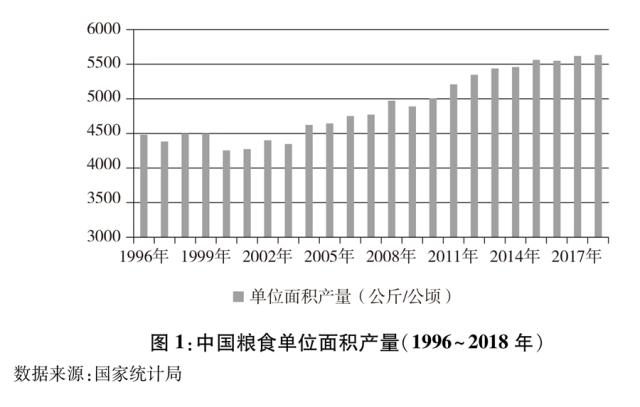
图1:中国粮食单位面积产量(1996~2018年) 新华社发
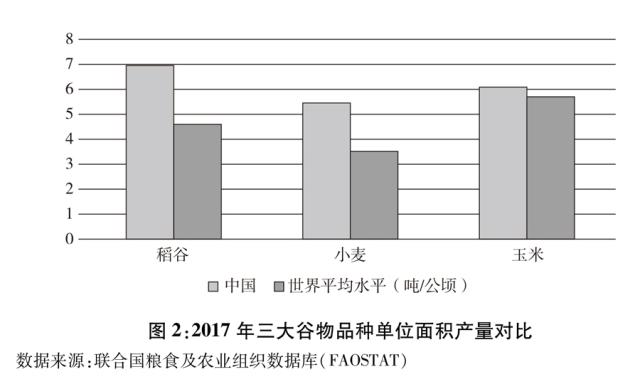
图2:2017年三大谷物品种单位面积产量对比 新华社发
——总产量连上新台阶。2010年突破5.5亿吨,2012年超过6亿吨,2015年达到6.6亿吨,连续4年稳定在6.5亿吨以上水平。2018年产量近6.6亿吨,比1996年的5亿吨增产30%以上,比1978年的3亿吨增产116%,是1949年1.1亿吨的近6倍。粮食产量波动幅度基本稳定在合理区间,除少数年份外,一般保持在±6%的范围之内。- Total food output has seen a steady increase. China's total food output surpassed
-550 million tons in 2010,
-600 million tons in 2012,
-660 million tons in 2015,
-650 million tons for four years from 2015.In 2018 the figure was near 660 million tons, up 30 percent over 1996(500 million tons), the year China published its first white paper on food security, 116 percent over 1978 (300 million tons), the year of the launch of China's reform and opening up, and by nearly 600 percent over 1949 (110 million tons), the year the PRC was founded.
Over the years food output each year has fluctuated within a range of plus or minus 6 percent, with the exception of a few years.
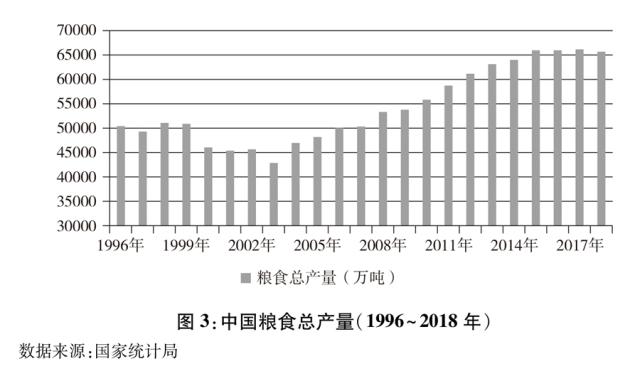
图3:中国粮食总产量(1996~2018年) 新华社发
(二)谷物供应基本自给2. Self-sufficiency in grain supply
——实现谷物基本自给。2018年,谷物产量6.1亿吨,占粮食总产量的90%以上,比1996年的4.5亿吨增加1.6亿吨。目前,我国谷物自给率超过95%,为保障国家粮食安全、促进经济社会发展和国家长治久安奠定了坚实的物质基础。- China is self-sufficient in grain supply. In 2018 the grain output was 610 million tons, accounting for more than 90 percent of total food output, and growing by 160 million tons over 1996. Currently China supplies 95 percent of its own needs for grain, laying down a solid material foundation for maintaining national food security, promoting socioeconomic development, and safeguarding long-term peace and stability.
——确保口粮绝对安全。近几年,稻谷和小麦产需有余,完全能够自给,进出口主要是品种调剂,将中国人的饭碗牢牢端在自己手上。2001年至2018年年均进口的粮食总量中,大豆占比为75.4%,稻谷和小麦两大口粮品种合计占比不足6%。- China ensures absolute security of staple grains. In 2001-2018, soybean accounted for 75.4 percent of imported grains, and the two main staple grains of rice and wheat together accounted for less than 6 percent. In recent years, with rice and wheat output meeting domestic needs, China is fully self-sufficient in food supply, and the main driver of food imports and exports is to satisfy the need for variety. China makes sure it relies on itself for food supply.
(三)粮食储备能力显著增强3. Greater food reserve capacity
——仓储现代化水平明显提高。2018年全国共有标准粮食仓房仓容6.7亿吨,简易仓容2.4亿吨,有效仓容总量比1996年增长31.9%。食用油罐总罐容2800万吨,比1996年增长7倍。规划建设了一批现代化新粮仓,维修改造了一批老粮库,仓容规模进一步增加,设施功能不断完善,安全储粮能力持续增强,总体达到了世界较先进水平。- Food storage is further modernized. In 2018 the storage capacity of qualified grain warehouses was 670 million tons, and that of simple warehouses was 240 million tons. Total effective warehouse capacity grew by 31.9 percent over 1996. The total tank capacity for edible oils was 28 million tons, a sevenfold increase over 1996. China has built new modern grain storage facilities and renovated old ones, further increasing storage capacity. With the facilities' functions also improved, China has secured a continued increase in its food storage capacity, generally reaching world advanced levels.
——物流能力大幅提升。2017年,全国粮食物流总量达到4.8亿吨,其中跨省物流量2.3亿吨。粮食物流骨干通道全部打通,公路、铁路、水路多式联运格局基本形成,原粮散粮运输、成品粮集装化运输比重大幅提高,粮食物流效率稳步提升。- Logistics capacity has increased markedly. In 2017, the total volume of food transported reached 480 million tons, including 230 million tons of interprovincial transport. All major channels of food logistics have been integrated to form a multimodal transport network composed of highways, railways and waterways. Food logistics now involves more unprocessed grain, bulk grain, and finished grain products transported by container. The efficiency of food logistics has seen steady improvement.
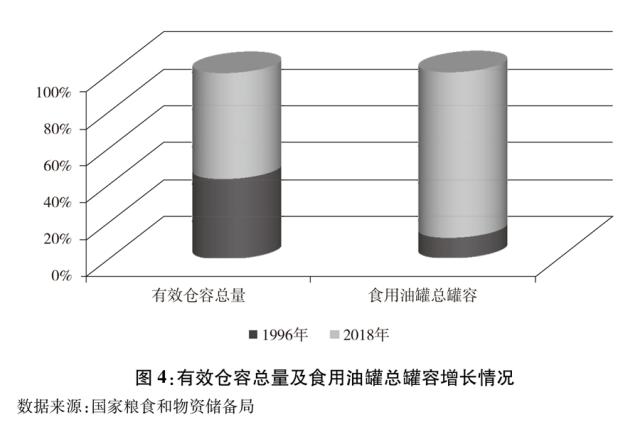
图4:有效仓容总量及食用油罐总罐容增长情况 新华社发
——粮食储备和应急体系逐步健全。政府粮食储备数量充足,质量良好,储存安全。在大中城市和价格易波动地区,建立了10-15天的应急成品粮储备。应急储备、加工和配送体系基本形成,应急供应网点遍布城乡街道社区,在应对地震、雨雪冰冻、台风等重大自然灾害和公共突发事件等方面发挥了重要作用。- Grain reserves and emergency response systems are improving. The government has sufficient and quality food reserves, with secured storage. Emergency food reserves for 10-15 days are available in large and medium-sized cities and areas prone to price fluctuation. A network of emergency reserves, processing and distribution is in place, with outlets to supply sub-districts and communities in urban and rural areas. These play an important role in response to natural disasters such as earthquakes, sleet, snowstorms, and typhoons, as well as public emergencies.
(四)居民健康营养状况明显改善4. Improved nutrition for residents
——膳食品种丰富多样。2018年,油料、猪牛羊肉、水产品、牛奶、蔬菜和水果的人均占有量分别为24.7公斤、46.8公斤、46.4公斤、22.1公斤、505.1公斤和184.4公斤,比1996年分别增加6.5公斤、16.6公斤、19.5公斤、17公斤、257.7公斤和117.7公斤,分别增长35.7%、55%、72.5%、333.3%、104.2%和176.5%。居民人均直接消费口粮减少,动物性食品、木本食物及蔬菜、瓜果等非粮食食物消费增加,食物更加多样,饮食更加健康。- More choices for meals. Per capita shares of various foods in 2018 and their increase over 1996 are as follows:
-oil, 24.7 kg, growing by 6.5 kg (35.7 percent up);
-pork, beef and mutton, 46.8 kg, growing by 16.6 kg (55 percent up);
-aquatic products, 46.4 kg, growing by 19.5 kg (72.5 percent up);
-milk, 22.1 kg, growing by 17 kg (333.3 percent up);
-vegetables, 505.1 kg, growing by 257.7 kg (104.2 percent up); and
-fruits, 184.4 kg, growing by 117.7 kg (176.5 percent up).
The per capita direct consumption of staple grains has decreased, and the consumption of non-grain foods such as meat and fish, ligneous foods, vegetables, and fruits has increased. The Chinese have more choices in what they eat and have a healthier diet.
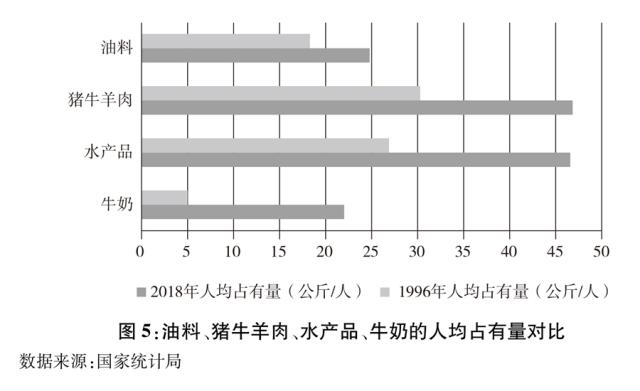
图5:油料、猪牛羊肉、水产品、牛奶的人均占有量对比 新华社发
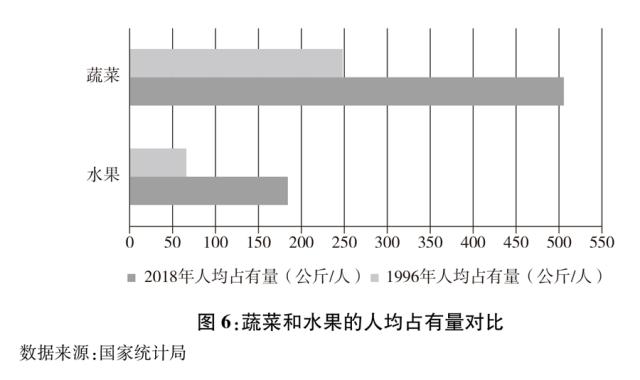
图6:蔬菜和水果的人均占有量对比 新华社发
——营养水平不断改善。据国家卫生健康委监测数据显示,中国居民平均每标准人日能量摄入量2172千卡,蛋白质65克,脂肪80克,碳水化合物301克。城乡居民膳食能量得到充足供给,蛋白质、脂肪、碳水化合物三大营养素供能充足,碳水化合物供能比下降,脂肪供能比上升,优质蛋白质摄入增加。- Improved nutrition. Data from the National Health Commission shows that the average daily energy intake of a standard person in China is 2,172 kcal, and the intakes of protein, fat and carbohydrate are 65g, 80g and 301g. Chinese citizens have an adequate supply of dietary energy, with sufficient intake of the three major nutrients - proteins, fat and carbohydrates. The proportion of carbohydrate intake has fallen, and those of fat and quality protein intake have risen.
(五)贫困人口吃饭问题有效解决5. Food for the poor
——中国农村贫困人口基本解决了“不愁吃”问题。中国高度重视消除饥饿和贫困问题,特别是党的十八大以来,探索出了一条发展农村经济、提高农民收入、消除饥饿和贫困的成功道路,精准扶贫、精准脱贫成效卓著。按现行农村贫困标准计算,2018年末,中国农村贫困人口数量1660万人,较2012年末的9899万人减少了8239万人,贫困发生率由10.2%降至1.7%;较1978年末的7.7亿人,累计减贫7.5亿人。按世界银行每人每天1.9美元的国际贫困标准,中国对全球减贫的贡献率超过70%,是世界上减贫人口最多的国家,也是世界上率先完成联合国千年发展目标中减贫目标的国家,贫困人口“不愁吃”的问题已基本解决。- Poor people in China no longer need to worry about food. The Chinese government has always attached great importance to eliminating hunger and poverty. Since the 18th National Congress of the CPC, in particular, it has explored ways to develop the rural economy, increase farmers' incomes, and eliminate hunger and poverty. Remarkable results have been achieved in targeted poverty alleviation and eradication. According to China's current poverty standards, as of the end of 2018 there remained 16.6 million people living in poverty in China. This represented a reduction of 82.39 million compared to 2012, and the incidence of poverty was down from 10.2 percent to 1.7 percent. The government has helped 750 million people out of poverty since 1978, when a staggering 770 million people were struggling for the means to live. According to the World Bank's poverty line of 1.9 US dollars per person per day, China has contributed more than 70 percent of the global poverty reduction effort. China has lifted more people out of poverty than any other country, and is the first country to reach the poverty reduction goal in the UN's Millennium Development Goals.
——重点贫困群体健康营养状况明显改善。2018年,贫困地区农村居民人均可支配收入达10371元人民币,实际增速高于全国农村1.7个百分点。收入水平的提高,增强了贫困地区的粮食获取能力,贫困人口粮谷类食物摄入量稳定增加。贫困地区青少年学生营养改善计划广泛实施,婴幼儿营养改善及老年营养健康试点项目效果显著,儿童、孕妇和老年人等重点人群营养水平明显提高,健康状况显著改善。- Nutrition for key groups in poverty has improved markedly. In 2018 the per capita disposable income of residents in impoverished rural areas reached 10,371 yuan, an actual increase of 1.7 percentage points higher than that of rural areas in general. This increase in income has enabled poor areas to acquire more food, and the intake of grains among poor groups has grown steadily. The government has carried out extensive nutrition improvement programs in poor areas for young students, infants, children, pregnant women, and the elderly, as a result of which there have been noticeable improvements in their nutrition and health.
二、中国特色粮食安全之路II. Food Security in China
中国立足本国国情、粮情,贯彻创新、协调、绿色、开放、共享的新发展理念,落实高质量发展要求,实施新时期国家粮食安全战略,走出了一条中国特色粮食安全之路。Based on its own national conditions and food availability, China has embarked on a road to establishing food security in its own way by implementing the concepts of innovative, coordinated, green, open, and inclusive development, the requirements of high-quality development, and a national food security strategy for a new era.
(一)稳步提升粮食生产能力1. Steadily increasing grain production capacity
——严守耕地保护红线。实施全国土地利用总体规划,从严管控各项建设占用耕地特别是优质耕地,健全建设用地“增存挂钩”机制,实行耕地占补平衡政策,严守12000万公顷耕地红线。全面落实永久基本农田特殊保护制度,划定永久基本农田10300多万公顷。目前,全国耕地面积13488万公顷,比1996年增加480多万公顷,粮食作物播种面积达到11700多万公顷,比1996年增加450万公顷左右,夯实了粮食生产基础。- Never crossing the red line for the protection of cultivated land. The Chinese government has implemented an overall plan for land use throughout the country. It strictly controls the occupation of cultivated land, especially high-quality land. It is improving the mechanism for linking the increase and deposit of construction land, and implementing a policy of balancing the occupation and replenishment of arable land, thus drawing a red line for its 120 million hectares of cultivated land. We have implemented a complete and special protection system for permanent basic farmland, and designated more than 103 million hectares of permanent basic farmland. At present, the country has 134.88 million hectares of cultivated land, an increase of more than 4.8 million hectares over 1996. There are more than 117 million hectares sown with grain, an increase of about 4.5 million hectares over 1996. The foundations of grain production have been strengthened.
——提升耕地质量,保护生态环境。实施全国高标准农田建设总体规划,推进耕地数量、质量、生态“三位一体”保护,改造中低产田,建设集中连片、旱涝保收、稳产高产、生态友好的高标准农田。2011年以来累计建成高标准农田4260多万公顷,项目区耕地质量提升1-2个等级,每公顷粮食产量提高约1500公斤,粮食生产能力得到提升。实行测土配方施肥,推广秸秆还田、绿肥种植、增施有机肥、地力培肥土壤改良等综合配套技术,稳步提升耕地质量。实施耕地休养生息规划,开展耕地轮作休耕制度试点。持续控制化肥、农药施用量,逐步消除面源污染,保护生态环境。- Improving the quality of arable land and protecting the environment. China has implemented an overall plan for the development of high-standard farmland, promoted the protection of quantity, quality and ecology of cultivated land, and upgraded medium-and low-yield fields. It has built high-standard farmland with concentrated contiguous land, guaranteed harvests in drought or flood, stable and high yield, and a sound ecology. Since 2011, we have created more than 42.6 million hectares of high-standard farmland, improved the quality of cultivated land by 1 to 2 grades in related zones, increased grain production by about 1,500 kg per hectare, and increased grain production capacity. We have carried out soil testing and formula fertilization, popularized the practice of returning straw to the field, green manure planting, the application of organic fertilizer, soil improvement and other supporting technologies, and steadily improved the quality of cultivated land. We have also implemented cultivated land rehabilitation planning and carried out a pilot system of fallow rotation of cultivated land. We will continue to control the application of chemical fertilizers and pesticides, gradually eliminate non-point source pollution, and protect the environment.
——建立粮食生产功能区和重要农产品生产保护区。以主体功能区规划和优势农产品布局规划为依托,以永久基本农田为基础,建立粮食生产功能区和重要农产品生产保护区。划定水稻、小麦、玉米等粮食生产功能区6000万公顷,大豆、油菜籽等重要农产品生产保护区近1500万公顷。加强建设东北稻谷、玉米、大豆优势产业带,形成黄淮海平原小麦、专用玉米和高蛋白大豆规模生产优势区;打造长江经济带双季稻和优质专用小麦生产核心区;提高西北优质小麦、玉米和马铃薯生产规模和质量;重点发展西南稻谷、小麦、玉米和马铃薯种植;扩大东南和华南优质双季稻和马铃薯产量规模。优化区域布局和要素组合,促进农业结构调整,提升农产品质量效益和市场竞争力,保障重要农产品特别是粮食的有效供给。- Establishing functional areas for grain production and protected areas for the production of important agricultural products. In accordance with the planning of the main functional areas and the configuration of superior agricultural products, China has established functional areas for grain production and protected areas for important agricultural products on the basis of permanent basic farmland. We have designated 60 million hectares of functional areas for grain production, such as rice, wheat and corn, and nearly 15 million hectares of protected areas for the production of important agricultural products such as soybeans and rapeseed. We have strengthened the superior industrial belt of rice, corn and soybeans in Northeast China, and formed a dominant area for the large-scale production of wheat, special corn and high-protein soybeans on the North China Plain. We are building a core area for the production of double-cropping rice and high-quality special wheat in the Yangtze River Economic Belt, and we are expanding the scale and improving the quality of high-quality wheat, corn and potatoes in Northwest China. In Southwest China we are focusing on the cultivation of rice, wheat, corn and potatoes, and increasing the yield of high-quality double-cropping rice and potatoes in Southeast and South China. We will continue to optimize the regional configuration and the combination of production factors, promote agricultural restructuring, enhance the quality and efficiency of agricultural products and market competitiveness, and ensure the effective supply of important agricultural products, especially grain.
——提高水资源利用效率。规划建设一批节水供水重大水利工程,开发种类齐全、系列配套、性能可靠的节水灌溉技术和产品,大力普及管灌、喷灌、微灌等节水灌溉技术,加大水肥一体化等农艺节水推广力度。加快灌区续建配套与现代化高效节水改造,推进小型农田水利设施达标提质,实现农业生产水资源科学高效利用。- Improving the efficiency of water resource utilization. The Chinese government has planned and built a number of major water conservancy projects for water saving and water supply. We have developed a full range of water-saving irrigation technologies and products that are reliable and complementary to each other. We have vigorously popularized water-saving irrigation technologies such as pipe irrigation, sprinkler irrigation and micro-irrigation, and promoted the integration of water and fertilizer and other agronomy water-saving technologies. We will further speed up the installation of support facilities and modern and efficient water-saving reconstruction in irrigation districts, standardize and improve the quality of small-scale irrigation facilities, and realize the scientific and efficient utilization of water resources in agricultural production.
(二)保护和调动粮食种植积极性2. Cultivating and arousing the enthusiasm of grain planting
——保障种粮农民收益。粮食生产不仅是解决粮食需求问题,更是解决农民就业问题的重要途径和手段。中国农业人口规模巨大,通过城镇化减少农业人口将是一个渐进的过程,在这个过程中必须保障农民的就业和收入。为全面促进农村经济社会的发展,国家相继取消牧业税、生猪屠宰税和农林特产税,特别是在2006年全面取消了在中国存在2600年的农业税,从根本上减轻了农民负担。逐步调整完善粮食价格形成机制和农业支持保护政策,通过实施耕地地力保护补贴和农机具购置补贴等措施,提高农民抵御自然风险和市场风险的能力,保障种粮基本收益,保护农民种粮积极性,确保农业可持续发展。- Guaranteeing farming incomes. Grain production makes an essential contribution to feeding the people; it also provides employment to farmers. China has a huge agricultural population, and it will be a gradual process to reduce the agricultural population through urbanization, during the course of which the employment and income of farmers must be guaranteed. In order to develop the rural economy and society in an all-around way, China has abolished the animal husbandry tax, pig slaughtering tax, tax on agricultural and forestry specialties and other taxes, especially the agricultural tax, which had existed in China for 2,600 years and was abolished in 2006. All these efforts have fundamentally reduced the burden on farmers.
We will gradually adjust and improve the grain price formation mechanism and agricultural support and protection policies, and improve farmers' ability to resist natural and market risks through the implementation of land fertility protection subsidies for cultivated land and subsidies for the purchase of agricultural machinery and equipment. We will guarantee the basic income of farmers, cultivate their enthusiasm for growing grain, and ensure the sustainable development of agriculture.
——完善生产经营方式。巩固农村基本经营制度,坚持以家庭承包经营为基础、统分结合的双层经营体制,调动亿万农民粮食生产积极性。着力培育新型农业经营主体和社会化服务组织,促进适度规模经营,把小农户引入现代农业发展轨道,逐步形成以家庭经营为基础、合作与联合为纽带、社会化服务为支撑的立体式复合型农业经营体系。目前,全国家庭农场近60万家,农民合作社达到217.3万家,社会化服务组织达到37万个,有效解决了“谁来种地”“怎样种地”等问题,大幅提高了农业生产效率。- Improving the mode of production and operation. China has consolidated the basic management system in rural areas, adhered to a two-tier management system based on household contract management and combined with unification and division, and aroused the enthusiasm of hundreds of millions of farmers in grain production. We have invested a great effort in cultivating new-type agricultural business entities and socialized service organizations, promoted moderate-scale operations, and guided small-scale farmers onto the track of modern agriculture, gradually forming a three-dimensional compound agricultural management system based on family management, with cooperation as the link, and social services as the support. At present there are nearly 600,000 family farms, 2.17 million farmers' cooperatives, and 370,000 social service organizations in China. The problems of "who farms the land" and "how to farm the land" have been effectively solved, and the efficiency of agricultural production has significantly improved.
(三)创新完善粮食市场体系3. Innovating and improving the food market system
——积极构建多元市场主体格局。深化国有粮食企业改革,鼓励发展混合所有制经济,促进国有粮食企业跨区域整合,打造骨干粮食企业集团。推动粮食产业转型升级,培育大型跨国粮食集团,支持中小粮食企业发展,促进形成公平竞争的市场环境。积极引导多元主体入市,市场化收购比重不断提高,粮食收购主体多元化格局逐步形成。- Building a pattern of multiple market players. China is furthering reform of state-owned grain enterprises, encouraging the development of a mixed ownership economy, promoting cross-regional integration of state-owned grain enterprises, and creating backbone grain enterprise groups. We will transform and upgrade the grain industry, cultivate large transnational grain groups, support the development of small and medium-sized grain enterprises, and foster a market environment for fair competition. We have actively guided multiple players into the market, and the proportion of market-based procurement has been increasing. A network of diversified grain purchasers has gradually taken shape.
——健全完善粮食交易体系。搭建了规范统一的国家粮食电子交易平台,形成以国家粮食电子交易平台为中心,省(区、市)粮食交易平台为支撑的国家粮食交易体系,服务宏观调控、服务粮食流通的功能不断提升。全国粮食商流、物流市场达到500多家。粮食期货交易品种涵盖小麦、玉米、稻谷和大豆等主要粮食品种,交易规模不断扩大。- Improving the grain trading system. China has built a standardized and unified national electronic grain trading platform, forming a national grain trading system with the platform as the center and provincial (autonomous regional, municipal) grain trading platforms as the support. The functions of macro-control and grain circulation have continuously improved. There are more than 500 grain commodity and logistics markets across the country. Grain futures trading cover major grain varieties such as wheat, corn, rice, and soybeans, and the scale is expanding.
——稳步提升粮食市场服务水平。积极引导各地发展多种粮食零售方式,完善城乡“放心粮油”供应网络,粮食电子商务和新型零售业态发展态势良好。搭建粮食产销合作平台,鼓励产销区加强政府层面战略合作。2018年组织各类粮食交易会3935场,成交粮食近13627万吨,成交金额2319亿元人民币。2018年和2019年,连续举办“中国粮食交易大会”,意向购销粮食达6000余万吨,推动产销合作水平迈上新台阶。- Steadily improving services in the grain market. The government has actively guided various localities to develop a variety of grain retail methods, and improved the supply network of "safe grain and oil" in urban and rural areas. Grain e-commerce and new forms of retail business are in good shape. We are building platforms for cooperation in grain production and marketing, and encouraging production and marketing areas to strengthen strategic cooperation at government level. In 2018, we organized 3,935 grain fairs of all kinds, with a transaction volume of nearly 136.27 million tons and a value of 231.9 billion yuan. In 2018 and 2019, China held China Grain Trade Conferences with an intended purchase and sale of more than 60 million tons, pushing grain production and marketing cooperation to a new level.
(四)健全完善国家宏观调控4. Improving macroeconomic regulation
——注重规划引领。编制《中华人民共和国国民经济和社会发展第十三个五年规划纲要》《国家粮食安全中长期规划纲要(2008-2020年)》《全国新增1000亿斤粮食生产能力规划(2009-2020年)》《中国食物与营养发展纲要(2014-2020年)》《全国农业可持续发展规划(2015-2030年)》《全国国土规划纲要(2016-2030年)》《国家乡村振兴战略规划(2018-2022年)》《粮食行业“十三五”发展规划纲要》等一系列发展规划,从不同层面制定目标、明确措施,引领农业现代化、粮食产业以及食物营养的发展方向,多维度维护国家粮食安全。- Paying close attention to state planning as guidance. China has formulated a series of plans, including the Outline of the Thirteenth Five-year Plan for National Economic and Social Development of the People's Republic of China, Outline of the Medium-and Long-term Plan for National Food Security (2008-2020), National Plan for an Increase of Production Capacity for 50 Billion Kg of Food (2009-2020), Outline of China's Food and Nutrition Development (2014-2020), National Agriculture Sustainable Development Plan (2015-2030), National Land Planning Outline (2016-2030), National Rural Vitalization Strategic Plan (2018-2022), and Outline of the 13th Five-year Development Plan for the Food Industry. Through these plans, China defines its goals and measures at different levels, and guides agricultural modernization, food nutrition, and the food industry, with the goal of safeguarding national food security in every respect.
——深化粮食收储制度和价格形成机制改革。为保护农民种粮积极性,促进农民就业增收,防止出现“谷贱伤农”和“卖粮难”,在特定时段、按照特定价格、对特定区域的特定粮食品种,先后实施了最低收购价收购、国家临时收储等政策性收购。收购价格由国家根据生产成本和市场行情确定,收购的粮食按照市场价格销售。随着市场形势发展变化,粮食供给更加充裕,按照分品种施策、渐进式推进的原则,积极稳妥推进粮食收储制度和价格形成机制改革。2014年起先后取消了大豆、油菜籽、玉米等粮油品种国家临时收储政策,全面实行市场化收购。2016年起逐步完善了稻谷和小麦最低收购价格政策,进一步降低了政策性收购比例,实现了以市场化收购为主。- Furthering reform of the grain collection and storage system and the price formation mechanism. In order to encourage farmers to grow grain, increase their employment prospects and incomes, and protect them from low grain prices and problems in selling their output, the government has, over specified periods, on specific grain varieties in specific regions, and in accordance with specific prices, carried out procurement policies including minimum purchase price procurement and temporary state collection and storage. The purchase price was determined by the government according to the production cost and the market situation, and the grain purchased was sold at the market price. As the market changes and develops, and as the grain supply increases, the government has made different policies for different grain varieties, actively and steadily promoted reform of the grain collection and storage system and the price formation mechanism. Since 2014, we have canceled the national temporary collection and storage policy of grain and oil varieties such as soybeans, rapeseed and corn, and carried out market-based procurement in an all-around way. Since 2016, we have gradually improved the minimum purchase price policy for rice and wheat, further reduced the proportion of policy procurement, and realized market-based procurement.
——发挥粮食储备重要作用。合理确定中央和地方储备功能定位,中央储备粮主要用于全国范围守底线、应大灾、稳预期,是国家粮食安全的“压舱石”;地方储备粮主要用于区域市场保应急、稳粮价、保供应,是国家粮食安全的第一道防线。- Giving full play to the important role of grain reserves. The government has a rational process for determining the functions of central and local reserves: the central grain reserves are mainly used to maintain basic needs, respond to disasters and stabilize expectations, which is the "ballast stone" of national food security. Local grain reserves are mainly used in the regional market to meet emergencies, stabilize grain prices and guarantee supply, which is the first line of defense of national food security.
(五)大力发展粮食产业经济5. Developing the grain industry economy
——加快推动粮食产业转型升级。紧紧围绕“粮头食尾”“农头工尾”,充分发挥加工企业的引擎带动作用,延伸粮食产业链,提升价值链,打造供应链,统筹建好示范市县、产业园区、骨干企业和优质粮食工程“四大载体”,在更高层次上提升国家粮食安全保障水平。- Speeding up the transformation and upgrading of the grain industry. China upholds the principle of "grain planting to the forefront and produce to follow (This means that grain planting should be the source, and produce should be found on the dining table, which requires us to properly deal with the relationship between planting and marketing)" and "agriculture to the forefront and industry to follow (This requires us to integrate the primary and secondary industries and realize intensive processing of agricultural products)", giving full play to the role of processing enterprises as the engine, extending the grain industry chain, upgrading the value chain, and building a supply chain. We have an overall strategy to build four major carriers to raise national food security to a higher level: demonstration cities and counties, industrial parks, backbone enterprises, and the Quality Food Project, so as to raise national food security to a higher level.
——积极发展粮食精深加工转化。增加专用米、专用粉、专用油、功能性淀粉糖、功能性蛋白等食品有效供给,促进居民膳食多元化。顺应饲料用粮需求快速增长趋势,积极发展饲料加工和转化,推动畜禽养殖发展,满足居民对肉蛋奶等的营养需求。- Transforming grain processing into refined and deep processing. China will increase the effective supply of special rice, special flour, special oil, functional starch sugar and protein, and promote dietary diversity among the people. We will continue to respond to the trend of rapid growth in feed demand, promote feed processing and transformation, facilitate the development of livestock and poultry breeding, and meet the nutritional needs of residents for meat, eggs and milk.
——深入实施优质粮食工程。建立专业化的粮食产后服务中心,为种粮农民提供清理、干燥、储存、加工、销售等服务。建立与完善由6个国家级、32个省级、305个市级和960个县级粮食质检机构构成的粮食质量安全检验监测体系,基本实现“机构成网络、监测全覆盖、监管无盲区”。制定发布“中国好粮油”系列标准,促进粮油产品提质升级,增加绿色优质粮油产品供给。- Implementing the Quality Food Project. China has established professional post-production grain service centers to provide cleaning, drying, storage, processing and marketing services for farmers. We have established and improved a grain quality and safety inspection and monitoring system composed of 6 national-level, 32 provincial-level, 305 municipal-level and 960 county-level grain quality inspection institutions, basically realizing the full coverage of the monitoring network. We have also formulated and issued a series of standards for grain and oil to upgrade the quality of grain and oil products and increase the supply of green grain and oil.
(六)全面建立粮食科技创新体系6. Establishing a comprehensive food science and technology innovation system
——强化粮食生产科技支撑。深入推进玉米、大豆、水稻、小麦国家良种重大科研联合攻关,大力培育推广优良品种。超级稻、矮败小麦、杂交玉米等高效育种技术体系基本建立,成功培育出数万个高产优质作物新品种新组合,实现了5-6次大规模更新换代,优良品种大面积推广应用,基本实现主要粮食作物良种全覆盖。中国科学家袁隆平培育的超级杂交稻单产达到每公顷近18.1吨,刷新了世界纪录。加快优质专用稻米和强筋弱筋小麦以及高淀粉、高蛋白、高油玉米等绿色优质品种选育,推动粮食生产从高产向优质高产并重转变。- Strengthening scientific and technological support for grain production. China has promoted research into improved varieties of corn, soybeans, rice and wheat, and made concerted efforts to cultivate and popularize the best varieties. Highly efficient technology is in place for cultivation of super rice, dwarf male-sterile wheat, and hybrid corn, and tens of thousands of new combinations of high yield and high quality crop varieties have been successfully cultivated after five or six phases of major upgrading. These have been popularized and applied over large areas, covering almost all major food crops. The per unit yield of super hybrid rice cultivated by Chinese scientist Yuan Longping has reached nearly 18.1 tons per hectare, setting a new world best. We will speed up the breeding of high-quality special rice, strong gluten and weak gluten wheat, and green and high-quality varieties such as high starch, high protein and high oil corn, and transform grain production from high yield to both high yield and high quality.
——推广应用农业科技。2018年,农业科技进步贡献率达到58.3%,比1996年的15.5%提高了42.8个百分点。科学施肥、节水灌溉、绿色防控等技术大面积推广,水稻、小麦、玉米三大粮食作物的农药、化肥利用率分别达到38.8%、37.8%,病虫草害损失率大幅降低。2004年以来实施粮食丰产科技工程,共建设丰产科技攻关田、核心区、示范区、辐射区1276个,累计增产粮食1.3亿吨,项目区单产增产量达到全国平均水平的2.3倍。农业科技的推广应用,为粮食增产发挥了积极作用。- Applying agricultural science and technology. In 2018, the contribution of scientific and technological progress to agriculture reached 58.3 percent, an increase of 42.8 percentage points from 15.5 percent in 1996. Scientific fertilization, water-saving irrigation, and green prevention and control have been popularized over large areas. That year pesticide and chemical fertilizer utilization rates for rice, wheat and corn reached 38.8 percent and 37.8 percent, and the loss rate from diseases, pests and weeds has fallen significantly. Since 2004, China has concentrated efforts to increase crop yield through science and technology, building a total of 1,276 research fields, core areas, demonstration areas and rollout areas, with a cumulative increase of 130 million tons of grain; the per unit yield in the project areas is as much as 2.3 times the national average. The popularization and application of agricultural science and technology has played a positive role in increasing grain output.
——提升粮食储运科技水平。攻克了一系列粮食储藏保鲜保质、虫霉防治和减损降耗关键技术难题,系统性解决了中国“北粮南运”散粮集装箱运输成套应用技术难题。不断扩大先进的仓储设施规模,2018年实现机械通风、粮情测控和环流熏蒸系统的仓容分别达到7.5亿吨、6.6亿吨和2.8亿吨。安全绿色储粮、质量安全、营养健康、加工转化、现代物流、“智慧粮食”等领域科研成果得到广泛应用。- Upgrading the science and technology of grain storage and transportation. China has overcome a series of key technological problems in grain storage and preservation, improving pest and mildew control, loss reduction, and ensuring freshness and quality, and systematically addressed the technical problems of container transportation in bringing bulk grain from North China to the South. China continues to expand the scale of advanced storage facilities, and in 2018 the storage capacity of mechanical ventilation reached 750 million tons. Storage capacity where grains can be monitored reached 660 million tons, and storage capacity featuring circulation fumigation was 280 million tons. Scientific research findings in the fields of safe and green grain storage, quality and safety, nutrition and health, processing and transformation, modern logistics, and "intelligent grain" have been widely applied.
(七)着力强化依法管理合规经营7. Strengthening management and operations in accordance with the law
——完善粮食安全保障法律法规。加快推进粮食安全保障立法,颁布和修订实施《农业法》《土地管理法》《土壤污染防治法》《水土保持法》《农村土地承包法》《农业技术推广法》《农业机械化促进法》《种子法》《农产品质量安全法》《进出境动植物检疫法》《农民专业合作社法》《基本农田保护条例》《土地复垦条例》《农药管理条例》《植物检疫条例》《粮食流通管理条例》等法律法规。- Improving laws and regulations on food security. To accelerate food security legislation, China has promulgated and revised the following laws and regulations:
-Agricultural Law
-Land Administration Law
-Soil Pollution Prevention and Control Law
-Law on Soil and Water Conservation
-Rural Land Contracting Law
-Law on the Popularization of Agricultural Technology
-Law on Promotion of Agricultural Mechanization
-Seed Law
-Law on Quality and Safety of Agricultural Products
-Law on the Entry and Exit Animal and Plant Quarantine-Law on Farmers' Specialized Cooperatives
-Regulations on the Protection of Basic Farmland
-Regulations on Land Reclamation
-Regulations on Pesticide Administration
-Regulations on Plant Quarantine
-Regulations on the Administration of Grain Circulation.
——落实粮食安全省长责任制。确保国家粮食安全,中央政府承担首要责任,省级政府承担主体责任。2014年底,国务院出台《关于建立健全粮食安全省长责任制的若干意见》,从生产、流通、消费等各个环节明确各省级政府在维护国家粮食安全方面的事权与责任。2015年,国务院办公厅印发《粮食安全省长责任制考核办法》,建立考核机制,明确由国家相关部门组成考核工作组,负责具体实施考核工作,进一步压实地方政府维护国家粮食安全的责任。地方政府粮食安全意识普遍增强,粮食安全保障水平不断提升。- Implementing the responsibility system of provincial governors for food security. In ensuring national food security, the central government should take overall responsibility, and the provincial governments bear the primary responsibility. At the end of 2014, the State Council issued the "Directives on Establishing and Improving the System of Provincial Governors' Responsibility for Food Security", defining the power and responsibilities of provincial governments in safeguarding national food security in terms of production, circulation and consumption. In 2015, the General Office of the State Council issued the "Measures for the Assessment of Provincial Governors' Responsibility for Food Security", established an assessment mechanism and formed a working group composed of relevant state departments, which was responsible for carrying out the assessment, thus further consolidating the responsibility of local governments in maintaining national food security. All local governments have increased their awareness of food security issues, and the level of food security has continuously improved.
——深化粮食“放管服”改革。持续推进简政放权、放管结合、优化服务,切实强化市场意识和法治思维,牢固树立依法管粮、依法治粮的意识,依法推进双随机监管机制及涉粮事项向社会公开。完善粮食库存检查方式方法和质量安全监管制度,构建粮油安全储存责任体系和行为准则,确保粮食库存数量真实、质量良好、储存安全。建立以信用监管为基础的新型监管机制,维护正常的粮食流通秩序。- Promoting reform in simplifying administration and delegating power, combining decentralization and management, and optimizing services. The goals are to strengthen market consciousness, reinforce thinking on the rule of law, foster an awareness of the need to manage and administer grain in accordance with the law, and strengthen supervision by such measures as random selection of targets for assessment and random selection of assessors, and timely provide information on grain-related affairs to the general public. We will improve the inspection methods of grain inventory and the quality and safety supervision system, and build a responsibility system and code of conduct for the safe storage of grain and oil, so as to ensure that grain stocks are accurate in quantity, good in quality, and safe in storage. We will continue to establish a new regulatory mechanism that mainly monitors the credibility of all players in the food industry to maintain the normal order of grain circulation.
三、对外开放与国际合作III. Opening Up and International Cooperation
中国积极践行自由贸易理念,认真履行加入世界贸易组织承诺,主动分享中国的粮食市场资源,推动世界粮食贸易发展。不断深化粮农领域国际合作,积极参与世界粮食安全治理,为促进世界粮食事业健康发展、维护世界粮食安全作出了重要贡献。China is an active promoter of free trade. It has worked hard to fulfill its commitments to the WTO, and shares China's food market resources to facilitate world food trade. By expanding international cooperation in food and agriculture and actively participating in global food security governance, China has made an important contribution to the healthy development of the world food industry and food security.
(一)对外开放日益扩大1. More areas are opening up
——中国粮食市场更加开放。涉粮外资企业加工转化粮食数量、产品销售收入不断增加,2018年分别占到全国的14.5%、17%。外资企业进入中国粮食市场的广度、深度不断拓展,在食用植物油、粮食加工转化等领域的份额不断增长,并向粮食收购市场、批发零售和主食品供应等方面延伸,成为促进中国粮食产业发展的重要力量。- The Chinese food market is more open than before. Foreign-funded enterprises in China have been processing more food, and their revenue from sales is increasing over the years, accounting for 14.5 percent and 17 percent of the national total in 2018. Foreign-funded enterprises are becoming more involved in depth and width of China's food market, with growing shares of business in edible vegetable oil and food processing, and activities extending into procurement, wholesale and retail, and staple food supply. They have become a key force in developing China's food industry.
——认真履行加入世界贸易组织承诺。中国严格按照加入世界贸易组织承诺,取消了相关农产品进口配额和许可证等非关税措施,对小麦、玉米、大米实施进口关税配额管理,大幅度削减其他粮食品种的进口关税。进一步放宽农业领域外商投资准入限制,除中国稀有和特有的珍贵品种、转基因品种之外,将外商投资种业的限制范围缩减为小麦、玉米,取消农产品收购、批发的外商投资准入限制。- China has honored its commitments to the WTO. In strict accordance with its commitments upon joining the WTO, China has rescinded import quotas, permits and other non-tariff measures for relevant agroproducts, exercised quota management for imported wheat, corn and rice, and cut import duties on other food types by large margins. It has further eased restrictions on foreign investment in agriculture, allowing foreign-invested seed companies to operate in all grain types other than wheat, corn, and rare species or species unique to China, or genetically modified crops. Restrictions on foreign-invested companies regarding the procurement, processing and wholesale of agroproducts have also been lifted.
——促进国际粮食贸易繁荣发展。中国在确保国家粮食安全的前提下,认真遵守世界贸易组织规则并履行中国加入世界贸易组织的相关承诺,积极与世界主要产粮国分享中国巨大的粮食市场。2018年,包括大豆等油料和饲料在内的粮食进口总量为11555万吨,出口总量366万吨,分别比1996年增长944.8%、171.1%。进口总量中大豆8803万吨;谷物及谷物粉进口2047万吨,占当年世界谷物贸易量的4.9%。- China works for the development and prosperity of international food trade. On the precondition of ensuring national food security, China strictly abides by WTO rules and fulfills its commitments to the organization, sharing its huge food market with major food-producing countries. In 2018, China imported 115.55 million tons of oil crops (including soybeans), feed and other foods, and exported 3.66 million tons of food. These figures represented growth of 945 percent and 171 percent over 1996. It imported 88.03 million tons of soybeans, and 20.47 million tons of grains and grain powders, accounting for 4.9 percent of world grain trade in 2018.
(二)国际合作全面加强2. International cooperation is strengthened in all areas
——主动分享粮食安全资源和经验。1996年以来,中国与联合国粮农组织实施了20多个多边南南合作项目,向非洲、亚洲、南太平洋、加勒比海等地区的近30个国家和地区派遣近1100人次粮农技术专家和技术员,约占联合国粮农组织南南合作项目派出总人数的60%。积极支持国内有条件的企业“走出去”,秉持共商共建共享原则,在有需要的国家和地区开展农业投资,推广粮食生产、加工、仓储、物流、贸易等技术和经验。截至2017年底,中国农业对外投资存量173.3亿美元,在境外设立企业851家,分布于六大洲的100个国家(地区),雇佣外方员工13.4万人,为东道国增加就业、发展经济、改善民生作出了积极贡献。- Sharing resources and experience on food security with the rest of the world. Since 1996, the Chinese government and the United Nations Food and Agriculture Organization (UNFAO) have jointly implemented more than 20 multilateral South-South cooperation programs, and sent 1,100 agricultural experts and technical personnel to around 30 countries and regions in Africa, Asia, the South Pacific, and the Caribbean, accounting for 60 percent of the total number of personnel dispatched by the UNFAO's South-South cooperation program. It supports competent food enterprises in going global, encouraging them to invest in agriculture in countries and regions where such investment is needed, and share with them technology and experience on food production, processing, storage, logistics, and trade in accordance with the principles of extensive consultation, joint contribution and shared benefits. By the end of 2017, China had a total investment of 17.33 billion US dollars in agriculture overseas, with 851 enterprises operating in 100 countries and regions in six continents and employing 134,000 foreign employees. They have helped these countries and regions create more jobs, develop their economy, and improve peoples' lives.
——不断深化国际合作。中国与60多个国家和国际组织签署了120多份粮食和农业多双边合作协议、60多份进出口粮食检疫议定书,与140多个国家和地区建立了农业科技交流和经济合作关系,与50多个国家和地区建立了双边农业合作工作组。中国始终将支持非洲农业发展和粮食安全作为对非合作的优先重点领域。截至2016年,中国共帮助50多个非洲国家实施近500个农业援助项目,包括成套项目、技术援助项目、物资项目等,涉及农业种植、粮食仓储、农业机械、农田灌溉及农产品加工等领域。2013年以来,中国积极推进共建“一带一路”,与参与国建立经贸合作关系,推动粮食领域合作。- Deeper international cooperation. China has signed more than 120 bilateral and multilateral agreements on food and agriculture cooperation with over 60 countries and international organizations, and more than 60 inspection and quarantine protocols for food imports and exports. It has established exchanges in agricultural science and economic cooperation with over 140 countries and regions, and formed bilateral work groups on agricultural cooperation with more than 50 countries and regions. China has always prioritized agricultural development and food security in its cooperation with African countries. As of 2016, China had provided assistance to more than 50 African countries in implementing nearly 500 agricultural programs, including complete projects, technical support and material supply, in the areas of farming, food storage, agricultural machinery, farmland irrigation, and agroproduct processing. Since it launched the Belt and Road Initiative in 2013, China has strengthened trade and economic relations with many participating countries to promote cooperation in the food industry.
——积极参与世界粮食安全治理。积极响应和参与联合国粮农组织、世界粮食计划署等涉粮国际组织的倡议和活动。推动增强非洲等发展中国家在涉粮国际组织中的代表性和发言权,支持发展中国家的合理诉求。致力于落实联合国2030年可持续发展议程,制定《中国落实2030年可持续发展议程国别方案》,发布《中国落实2030年可持续发展议程进展报告》,为其他国家落实工作提供有益借鉴。积极参与国际食品法典、国际植物保护公约等国际规则制定,成功推动世界动物卫生组织、国际标准化组织等10多项农药残留国际标准、谷物国际运输标准、国际贸易粮食检疫措施标准等国际标准的制定,主导制修订小麦规格、玉米规格等多项粮食国际标准。牵头推动亚洲合作对话“粮食、水与能源安全相互关系”工作,积极参与东盟与中日韩10+3大米紧急储备机制,先后发起或主办亚太经合组织农业和粮食安全部长会议、二十国集团农业部长会议、金砖国家农业部长会议、中国-拉丁美洲和加勒比农业部长论坛、中国-太平洋岛国农业部长会议、世界农业展望大会等重要国际会议,推动各国在粮食安全治理方面形成共识。- Actively participating in world food security governance. China has actively responded to and participated in the initiatives and activities organized by the UNFAO, the World Food Programme, and other international organizations for agriculture. It has worked to enhance the representation and voice of Africa and other developing countries in international organizations for agriculture, lending support to their reasonable demands. It is committed to implementing the UN's 2030 Agenda for Sustainable Development, and has developed its country program for the Agenda and released a report on its progress for the Agenda, providing beneficial experience for other countries to do their work. China is engaged in the development of the Codex Alimentarius, International Plant Protection Convention, and other international rules. It led the formulation of and revisions to international standards on the specifications of wheat, corn, and other foods, and facilitated the development of about a dozen international standards on pesticide residues, grain transport, and food inspection and quarantine in foreign trade initiated by the World Organization for Animal Health and the International Standardization Organization. In order to push for consensus on food security governance, it took the lead in promoting the Asia Cooperation Dialogue on the relationship of food, water and energy security, and joined the 10+3 rice emergency reserve between ASEAN countries, China, Japan, and the ROK. It has also initiated or hosted APEC ministerial meetings on agriculture and food security, G20 meetings of agricultural ministers, BRICS meetings of agricultural ministers, the China-Latin America and the Caribbean Agricultural Ministers Forum, the China-Pacific Island Countries Agriculture Ministers Meeting, and the World Agricultural Outlook Conference.
——提供力所能及的国际紧急粮食援助。应有关国家紧急粮食援助请求,无偿提供力所能及的多双边紧急粮食援助,对缓解有关国家人道主义危机、促进世界消除饥饿目标的实现,发挥了积极作用,得到国际社会和有关国家的高度评价。- Providing emergency food assistance within its capacity. In response to the emergency food needs of other countries, China has provided bilateral and multilateral free emergency food assistance within its capacity, playing a positive role in alleviating humanitarian crises and facilitating global efforts toward eliminating hunger, for which it has won recognition and commendation from the international community.
四、未来展望与政策主张IV. Prospects and Policies
当前,中国粮食连年丰收、库存充裕、供应充足、市场稳定,粮食安全形势持续向好。展望未来,中国有条件、有能力、有信心依靠自身力量筑牢国家粮食安全防线。国家粮食安全保障政策体系基本成型,全面实施国家粮食安全战略,依靠自己保口粮,集中国内资源保重点,使粮食之基更牢靠、发展之基更深厚、社会之基更稳定。农业供给侧结构性改革尚有很大空间,粮食科技进步、单产提高、减少损失浪费、利用非粮食食物等方面还有较大潜力可供挖掘。充足的粮食储备可以保障粮食市场供应和市场基本稳定,现代化的粮食仓储物流体系可以防止出现区域性阶段性粮食供给紧张问题,市场机制充分发挥作用能够解决品种结构矛盾。China has recently enjoyed a run of good harvests. There are adequate grain supplies and reserves, and a stable grain market, which are indicators of increasing food security. Looking to the future, China has the conditions, capabilities and confidence to enhance food security relying on its own efforts. A national system of food security guarantee policies is in place. China's food strategy in the new era consists of ensuring security of food through food self-sufficiency, pooling domestic resources to ensure key links in food security, and securing food supply as a foundation for national development and social stability. There is plenty of space for supply-side structural reform in China's agriculture industry; there is plenty of room for progress in China's agro-technology, in terms of increasing per unit area yield, reducing food waste, and developing non-grain foods. Adequate grain reserves help ensure market supply and a basically stable market; a modernized grain storage and logistics system helps prevent regional or provisional food supply crises; market mechanisms in full play help improve the structure of grain varieties.
从中长期看,中国的粮食产需仍将维持紧平衡态势,确保国家粮食安全这根弦一刻也不能放松。从需求形势看,随着经济社会发展,人均口粮消费将稳中略降,饲料和工业转化用粮消费继续增加,粮食消费总量刚性增长,粮食消费结构不断升级。从生产形势看,农业生产成本仍在攀升,资源环境承载能力趋紧,农业基础设施相对薄弱,抗灾减灾能力有待提升,在确保绿色发展和资源永续利用的同时,稳定发展粮食生产压力较大。从流通形势看,粮食生产将继续向核心产区集中,跨区域粮食流通量将进一步增加,粮食市场大幅波动的风险依然存在。In the medium to long term, China's grain production and demand will remain closely aligned, which means China must not slacken its efforts to ensure food security. Per capita grain consumption and demand will drop slightly with social and economic development; the consumption of grain as feed for livestock and grain used for industrial purposes will continue to rise; total grain consumption will increase and pursue higher quality. In terms of grain production, agricultural costs are still rising, and resource and environmental carrying capacity (RECC) is broaching its limit. Agricultural infrastructure is comparatively weak, and capacity for disaster prevention and relief must be improved. China will find itself under considerable pressure to maintain steady grain production while ensuring green development and sustainable resource use. In terms of grain circulation, grain production will continue to be concentrated in core production areas. Transregional grain flows will increase, and there is still the risk of dramatic fluctuations in the grain market.
展望世界粮食安全形势,国际粮农机构全球粮食安全治理效果逐步显现,各国促进国际粮食市场有序流通、维护世界粮食市场总体稳定的愿望增强,贫困缺粮国家粮食生产得到发展,能够减轻国际市场波动对国内市场带来的不利影响,为中国和世界粮食安全营造良好环境。与此同时,当今世界粮食安全挑战依然严峻,仍有8亿多饥饿人口,国际粮食贸易面临着保护主义和单边主义的干扰,不稳定因素增加,实现相关可持续发展目标任重道远。In global terms, international institutions for food and agriculture have achieved outcomes in improving global food security governance. All countries have an increasing will to facilitate orderly circulation in the international food market and overall stability. Progress has been made in grain production in low-income food-deficit countries, which will mitigate the negative impact of international market fluctuations upon domestic markets, and create a sound environment for China's and for global food security.At the same time, today's world is still facing severe food security challenges. There are still over 800 million people suffering from hunger, while international food trade is being disrupted by protectionism and unilateralism, and showing increasing instability. These challenges mean that the world has a long way to go in reaching its sustainable development goals.
立足国内,放眼全球,中国将继续坚定不移地走中国特色粮食安全之路,全面贯彻新发展理念,全面实施国家粮食安全战略和乡村振兴战略,全面落实“藏粮于地、藏粮于技”战略,推动从粮食生产大国向粮食产业强国迈进,把饭碗牢牢端在自己手上,在确保国家粮食安全的同时,与世界各国携手应对全球饥饿问题,继续在南南合作框架下为其他发展中国家提供力所能及的帮助,共同推进全球粮食事业健康发展。In view of domestic and global food security, China will forge ahead along its own path. Pursuing a new development philosophy, China will implement its national strategies for food security and rural vitalization through sustainable farmland use and agricultural technology innovation to increase farmland productivity. China will advance from a large grain producer to a food industry power, holding firm its "rice bowl". While ensuring domestic food security, China will join the global fight against hunger. China will continue to provide assistance to the best of its ability to other developing countries within the framework of South-South cooperation, and promote the sound development of the global food industry.
(一)提高粮食生产能力1. Enhancing food productivity
——坚守耕地保护红线,节约和高效利用水资源。到2020年,落实12436万公顷耕地保有量、10307万公顷永久基本农田、4072万公顷建设用地总规模约束性指标,确保建成5333万公顷高标准农田,全面完成粮食生产功能区和重要农产品生产保护区建设,粮食种植面积稳定在1.1亿公顷以上,粮食综合生产能力稳定在6亿吨以上。不断提高耕地质量,到2022年,确保建成6667万公顷高标准农田。到2035年,粮食种植面积保持总体稳定。加快推进节水供水重大水利工程建设,不断完善农田水利设施,提高水资源利用效率。- Keeping to the red line for the protection of cultivated land and saving and utilizing water resources efficiently. By 2020, China will implement the following mandatory indexes and achieve the following targets:
-124 million ha of cultivated land,
-103 million ha of permanent basic farmland,
-no more than 40.7 million ha of land for construction,
-53.3 million ha of high-standard farmland,
-complete functional areas for grain production and protected areas for the production of important agricultural products,
-maintain a grain planting area of above 110 million ha, and
-maintain a comprehensive grain production capacity of above 600 million tons.
China will continue to improve farmland quality. By 2022, it will complete the construction of 66.67 million ha of high-standard farmland, and by 2035, it will keep its grain planting area generally steady. It will implement major hydro construction projects for water conservation and supply, improve farmland hydro facilities, and increase water resource utilization efficiency.
——推进种植结构调整,增加绿色优质粮油产品供给。稳定谷物种植面积,因地制宜发展薯类、豆类、杂粮等作物。大力发展强筋弱筋小麦、优质稻谷、青贮及专用玉米、高油高蛋白大豆等,通过优质优价促进农民增收。继续实施优质粮食工程和“中国好粮油”行动计划,服务绿色农业发展和“健康中国”建设,大力增加绿色优质粮油产品供给。- Adjusting the crop planting structure and increasing the supply of green and high-quality grain and edible oil. China will keep its grain planting area steady, and develop tuber crops, legume crops, and miscellaneous grain crops in accordance with local conditions. Crop varieties will include strong gluten wheat, weak gluten wheat, high-quality rice, silage corn, special corn, and high-oleic and high-protein soybean. Farmers' incomes will increase by selling high-quality produce at higher prices. China will continue implementing the Quality Food Project and the Healthy Grain and Edible Oil Action Plan, facilitate green agricultural development and the Healthy China initiative, and increase the supply of green and high-quality grain and edible oil.
——创新体制机制,提高粮食生产组织化程度。推动农村承包土地所有权、承包权、经营权“三权分置”有序实施,培育新型经营主体和服务主体,发展土地流转型和服务引领型规模经营,促进小规模、分散经营向适度规模、主体多元转变。加强新型职业农民培训,支持农民通过股份制、股份合作制等多种形式参与规模化、产业化经营。完善针对小农户的扶持政策,把小农户引入现代农业发展轨道。- Upgrading institutions and mechanisms for better organized grain production. China will separate the ownership, contracting right and management right of rural contracted land in an orderly manner. It will foster new types of operating and service entities, promote moderate-scale management oriented by land transfer and service, and transform small-scale, decentralized management into moderate-scale, multi-entity management. A new generation of professional farmers will benefit from better technical training, who will be encouraged to participate in large-scale, industrialized management through shareholding and shareholding cooperative systems. China will improve policies to support small agricultural households, and help them adapt to modern agricultural development.
——增强农业科技创新能力,提高粮食生产水平。强化农业基础研究,全面升级节水灌溉、农机装备、农药研制、肥料开发、加工储运、循环农业等应用技术。强化种业科技创新,突破种质创新、新品种选育、高效繁育和加工流通等核心技术。强化技术集成创新,攻克影响作物单产提高、品质提升、效益增加、环境改善的技术瓶颈。推进农业机械化和农机装备产业转型升级,依靠科技手段和农艺农技应用,增加粮食供给,提升粮食品质。- Enhancing agro-technological innovation and improving grain production capacity. China will promote basic agricultural research and upgrade technologies in water conservation and irritation, and focus on agricultural machinery, pesticide R&D, fertilizer development, the processing, storage and transport of grain, and circular agriculture. China will continue to innovate in the seed industry, making breakthroughs in core technologies such as germ plasm improvement, and the creation, efficient cultivation, processing, and circulation of new crop varieties. China will enhance integrated technological innovation, breaking logjams in improving per unit area yield, crop quality, economic benefits, and the environment. China will promote mechanization in agriculture and transform and upgrade the agricultural machinery industry, increasing grain supply and improving grain quality through the application of agronomy and agro-techniques.
(二)加强储备应急管理2. Improving the management of emergency grain reserves
——加强粮食储备管理。以服务宏观调控、调节稳定市场、应对突发事件和提升国家安全能力为目标,科学确定粮食储备功能和规模,改革完善粮食储备管理体制,健全粮食储备运行机制,强化内控管理和外部监督,加快构建更高层次、更高质量、更有效率、更可持续的粮食安全保障体系。- Improving the management of grain reserves. To facilitate macroregulation, a steady market, sound emergency response, and national security, China will apply scientific rationale in designing the functions and scale of grain reserves. It will reform and complete its management mechanisms, improve its operating mechanisms, and strengthen internal management and external supervision. The goal is to build a food security guarantee system which is more advanced, effective, efficient and sustainable.
——健全粮食应急保供体系。优化粮食应急供应、配送、加工网点的布局,建成一批规范化粮油配送中心、粮油应急加工企业和应急供应网点,形成布局合理、设施完备、运转高效、保障有力的粮食应急供应保障体系,强化应急处置功能,提升应急供应保障水平。- Improving the emergency grain supply guarantee system. China will establish a network for the supply, delivery and processing of grain for emergency use. A number of standardized delivery centers, emergency processing enterprises, and emergency supply centers for grain and edible oil. China will form an emergency grain supply guarantee system with well-distributed shops and complete equipment that runs efficiently and provides solid support. China will enhance emergency response functions and guarantee emergency supplies.
——完善粮情预警监测体系。强化粮油市场预警机制,加快建立健全涵盖国家、省、市、县四级的监测预警体系,依托信息技术准确把握国内外粮食形势,健全粮油市场监测网络,提供及时、准确、全面的市场信息服务,防范市场异常波动风险。- Improving the grain monitoring and pre-warning system. China will improve the pre-warning mechanisms for the grain and edible oil market by establishing a national monitoring and pre-warning system at the state, provincial, municipal and county levels. China will accurately follow domestic and international grain developments through IT application. China will improve the monitoring network for the grain and edible oil market, to provide timely, accurate and all-faceted market information services, and to guard against abnormal market fluctuations.
——倡导节粮减损。大力开展宣传教育活动,增强爱粮节粮意识,抑制不合理消费需求,减少“餐桌上的浪费”,形成科学消费、健康消费、文明消费的良好风尚。普及推广经济、适用、防虫、防霉储粮新装具、新技术,帮助农民减少产后损失。示范推广绿色、环保、智能粮食储藏设施设备,鼓励适度加工,提高物流效率,减少粮食流通环节的损失损耗。- Encouraging grain conservation and reducing losses. China will launch publicity and education activities to enhance public awareness of food conservation, contain unnecessary consumption, reduce food waste, and to foster rational, healthy and civilized consumption. China will popularize new equipment and technologies for grain storage that are economical, effective, insect-resistant and mildew-proof, to reduce farmers' postproduction losses. China will popularize green, eco-friendly and smart equipment and facilities for grain storage, encourage moderate processing, raise logistics efficiency, and reduce circulation losses and spoilage.
(三)建设现代粮食流通体系3. Building a modern grain circulation system
——加快建设现代粮食市场体系。坚持市场化改革取向与保护农民利益并重,以确保口粮绝对安全、防止“谷贱伤农”为底线,适应世界贸易组织规则,积极稳妥推进粮食收储制度和价格形成机制改革,充分发挥市场配置粮食资源的决定性作用,更好发挥政府作用,使粮价更好地反映市场供求,激发市场活力,促进供需平衡,加快形成统一开放、竞争有序的现代粮食市场体系。- Stepping up efforts to build a modern grain market system. China places equal importance on market-oriented reform and protecting farmers' interests. Upholding its red line of absolute security of staple food and zero risk to farmers from low grain prices, China will adapt itself to the WTO rules, actively and steadily reform its grain purchase and storage systems and pricing mechanisms, giving full play to the decisive role of market in allocating grain resources, and letting the government play its role better. Through these measures, China hopes that grain prices can better reflect market demand and supply, that market vitality will be boosted, and a balance between demand and supply can be achieved, to form a unified and open modern grain market system with orderly competition.
——切实加强粮食仓储物流建设。围绕优化布局、调整结构、提升功能,鼓励合理改建、扩建和新建粮食仓储物流设施,持续推进粮库智能化升级,增强安全运行保障能力。优化大型粮食物流园区布局,构建一批粮食进出口物流通道和重要节点,提升粮食物流重点线路流通效率。- Improving grain storage and logistics. Focusing on improving distribution, structure and functions, China will encourage rational reconstruction, expansion and construction of grain storage and logistics facilities, to advance the smart management of grain depots and guarantee their safe operation. China will improve the distribution of large grain logistics parks, and build logistics passageways and major junctions for grain imports and exports, to increase efficient circulation on major grain logistics routes.
——着力构建现代化粮食产业体系。坚持高质量发展要求,倡导推广粮食循环经济模式。发展粮食精深加工与转化,大力推进主食产业化,不断增加绿色优质和特色粮油产品供给。着力推动优粮优产、优粮优购、优粮优储、优粮优加、优粮优销,加快构建现代化粮食产业体系。- Building a modernized grain industry system. Pursuing high-quality development, China encourages a circular food economy. China will develop deep and intensive processing and conversion of grain, industrialize the processing of staple food, and increase the supply of green, high-quality and specialty grains and edible oils. China will boost the production of high-quality grain, purchase it at higher prices, and prioritize its storage, processing and sales. China will move faster to build a modernized grain industry system.
(四)积极维护世界粮食安全4. Safeguarding global food security
——继续深入推进南南合作,为实现联合国2030年可持续发展目标中的“消除饥饿,实现粮食安全,改善营养状况和促进可持续农业”作出积极努力。- Advancing South-South cooperation. China will work hard to achieve the goals set in the United Nations 2030 Agenda for Sustainable Development: "End hunger, achieve food security and improved nutrition and promote sustainable agriculture."
——深化与共建“一带一路”国家的粮食经贸合作关系,共同打造国际粮食合作新平台,促进沿线国家的农业资源要素有序自由流动、市场深度融合。- Enhancing grain trade cooperation with the countries along the routes of the Belt and Road. Together, we will establish a new international platform for grain cooperation, to facilitate the free and orderly flow of agricultural resources and deep integration of markets in the Belt and Road countries.
——积极支持粮食企业“走出去”“引进来”,开展国际合作,合理利用国际国内两个市场、两种资源。优化粮食进口渠道,拓展多元化粮食来源市场,促进全球范围内粮食资源合理高效配置。- Supporting Chinese grain enterprises in "going global" and "bringing in". China will make rational use of both domestic and international markets and resources. China will improve grain import channels, expand diversified food resource markets, and promote rational and efficient allocation of global grain resources.
——积极参与全球和区域粮食安全治理,积极探索国际粮食合作新模式,开展全方位、高水平粮食对外合作,维护世界贸易组织规则,促进形成更加安全、稳定、合理的国际粮食安全新局面,更好地维护世界粮食安全。- Engaging in global and regional food security governance. China will explore new modes of international food cooperation, and conduct multifaceted and advanced cooperation with other countries. Observing WTO rules, China will do all it can to make international food security more secure, stable and rational in order to better safeguard food security of our world.
结束语Conclusion
凡益之道,与时偕行。进入新时代,中国人民更加关注食物的营养与健康,既要“吃得饱”,更要“吃得好”“吃得放心”。初心不忘,人民至上。中国将在习近平新时代中国特色社会主义思想指引下,始终以人民对美好生活的向往为奋斗目标,牢固树立总体国家安全观,深入实施国家粮食安全战略和乡村振兴战略,进一步加强粮食生产能力、储备能力、流通能力建设,推动粮食产业高质量发展,提高国家粮食安全保障能力,为人民获得更多福祉奠定坚实根基。There is an ancient Chinese teaching: All good principles should adapt to changing times to remain relevant. In the new era, the Chinese people are more concerned with their nutrition and health, from having enough food to eat to eating well and safely. The people's needs are the highest responsibility of the Chinese government. In line with Xi Jinping Thought on Socialism with Chinese Characteristics for a New Era, China will see that the people are able to realize their expectations for a better life. Pursuing a holistic approach to national security, China will further implement its national strategies for food security and rural vitalization. As a foundation for providing greater well-being for the people, China will increase food productivity, boost grain reserves, and improve grain circulation, to facilitate the high-quality development of its grain industries and strengthen the food security guarantee.
确保粮食安全,中国与世界命运休戚与共。中国将继续遵循开放包容、平等互利、合作共赢的原则,努力构建粮食对外开放新格局,与世界各国一道,加强合作,共同发展,为维护世界粮食安全作出不懈努力,为推动构建人类命运共同体作出新的贡献。China has allied itself with the global effort to ensure food security. Under the principle of openness, inclusiveness, equality, mutual benefit, and win-win cooperation, China will be embracing a new situation of opening up with regard to food issues. In pursuit of common development, China is enhancing cooperation with all other countries to safeguard global food security, as a contribution to building a global community of shared future.
来源:新华网
1.《粮食安全白皮书 《中国的粮食安全》白皮书(双语全文)》援引自互联网,旨在传递更多网络信息知识,仅代表作者本人观点,与本网站无关,侵删请联系页脚下方联系方式。
2.《粮食安全白皮书 《中国的粮食安全》白皮书(双语全文)》仅供读者参考,本网站未对该内容进行证实,对其原创性、真实性、完整性、及时性不作任何保证。
3.文章转载时请保留本站内容来源地址,https://www.lu-xu.com/yule/2021-04-10/1243871.html

